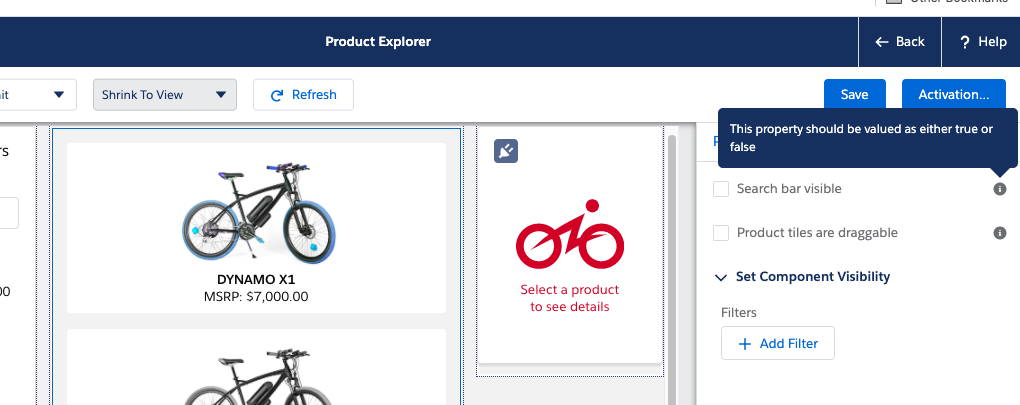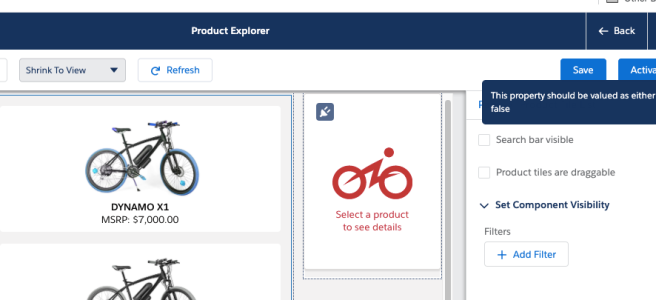In case you did not realize, Salesforce Lightning components can be one of two flavors:
- Aura components – Launched in 2015 and up until early 2019 were called Lightning components.
- Lightning web components (LWC’s) – Launched in 2019 and are considered the future of Salesforce development.
Design for Configurability
Whichever flavor you select, the tip in this post applies to both Aura components and the new Lightning web components.
So what does creating Admin friendly Lightning components mean?
In a nutshell, it means making your component as configureable as possible to anyone using it to assemble Lightning pages using Lightning App Builder. This is done by using a meta configuration file for LWC’s or a design resource file for Aura components.
Whichever flavor you chose, the tip in this post applies to both Aura components and the new Lightning web components.
To give you an example of how that is done for LWC’s, let’s look at the code for the eBikes sample app, which can be found here for the LWC version. This is what the HTML for that component looks like:
<template>
<div class="slds-card slds-p-around_x-small">
<template if:true={searchBarIsVisible}>
<lightning-input
label="Search Key"
type="text"
onchange={handleSearchKeyChange}
class="search-bar"
></lightning-input>
</template>
<template if:true={products.data}>
<template if:true={products.data.records.length}>
<div class="content">
<template
for:each={products.data.records}
for:item="product"
>
<c-product-tile
key={product.Id}
product={product}
draggable={tilesAreDraggable}
onselected={handleProductSelected}
class="slds-m-around_x-small"
>
</c-product-tile>
</template>
</div>
<c-paginator
page-number={pageNumber}
page-size={products.data.pageSize}
total-item-count={products.data.totalItemCount}
onprevious={handlePreviousPage}
onnext={handleNextPage}
></c-paginator>
</template>
<template if:false={products.data.records.length}>
<c-placeholder
message="There are no products matching your current selection"
></c-placeholder>
</template>
</template>
<template if:true={products.error}>
<c-error-panel errors={products.error}></c-error-panel>
</template>
</div>
</template>And here is the JavaScript controller file:
import { LightningElement, api, wire } from 'lwc';
// Ligthning Message Service and message channels
import { publish, subscribe, MessageContext } from 'lightning/messageService';
import PRODUCTS_FILTERED_MESSAGE from '@salesforce/messageChannel/ProductsFiltered__c';
import PRODUCT_SELECTED_MESSAGE from '@salesforce/messageChannel/ProductSelected__c';
// getProducts() method in ProductController Apex class
import getProducts from '@salesforce/apex/ProductController.getProducts';
/**
* Container component that loads and displays a list of Product__c records.
*/
export default class ProductTileList extends LightningElement {
/**
* Whether to display the search bar.
* TODO - normalize value because it may come as a boolean, string or otherwise.
*/
@api searchBarIsVisible = false;
/**
* Whether the product tiles are draggable.
* TODO - normalize value because it may come as a boolean, string or otherwise.
*/
@api tilesAreDraggable = false;
/** Current page in the product list. */
pageNumber = 1;
/** The number of items on a page. */
pageSize;
/** The total number of items matching the selection. */
totalItemCount = 0;
/** JSON.stringified version of filters to pass to apex */
filters = {};
/** Load context for Ligthning Messaging Service */
@wire(MessageContext) messageContext;
/** Subscription for ProductsFiltered Ligthning message */
productFilterSubscription;
/**
* Load the list of available products.
*/
@wire(getProducts, { filters: '$filters', pageNumber: '$pageNumber' })
products;
connectedCallback() {
// Subscribe to ProductsFiltered message
this.productFilterSubscription = subscribe(
this.messageContext,
PRODUCTS_FILTERED_MESSAGE,
(message) => this.handleFilterChange(message)
);
}
handleProductSelected(event) {
// Published ProductSelected message
publish(this.messageContext, PRODUCT_SELECTED_MESSAGE, {
productId: event.detail
});
}
handleSearchKeyChange(event) {
this.filters = {
searchKey: event.target.value.toLowerCase()
};
this.pageNumber = 1;
}
handleFilterChange(message) {
this.filters = { ...message.filters };
this.pageNumber = 1;
}
handlePreviousPage() {
this.pageNumber = this.pageNumber - 1;
}
handleNextPage() {
this.pageNumber = this.pageNumber + 1;
}
}Notice that the searchBarIsVisible and titlesAreDraggable properties use the @api decorator and that the developer has kindly added a TODO comment here suggesting that the normalized value may come as a boolean, string or otherwise.
The reason the values may some across differently is because these two properties are configureable in the design file, but only for Record Pages and Community default pages. This means that anyone can use Lightning App Builder to change those values (well, at least for Record and Community Default pages).
To see how this is done, let’s take a look at the meta configuration file for this component:
<?xml version="1.0" encoding="UTF-8" ?>
<LightningComponentBundle xmlns="http://soap.sforce.com/2006/04/metadata">
<apiVersion>49.0</apiVersion>
<isExposed>true</isExposed>
<masterLabel>Product Tile List</masterLabel>
<targets>
<target>lightning__AppPage</target>
<target>lightning__RecordPage</target>
<target>lightning__HomePage</target>
<target>lightningCommunity__Page</target>
<target>lightningCommunity__Default</target>
</targets>
<targetConfigs>
<targetConfig targets="lightning__RecordPage">
<property
name="searchBarIsVisible"
type="Boolean"
label="Search bar visible"
/>
<property
name="tilesAreDraggable"
type="Boolean"
label="Product tiles are draggable"
/>
<objects>
<object>Order__c</object>
</objects>
</targetConfig>
<targetConfig targets="lightningCommunity__Default">
<property
name="searchBarIsVisible"
type="Boolean"
label="Search bar visible"
/>
<property
name="tilesAreDraggable"
type="Boolean"
label="Product tiles are draggable"
/>
</targetConfig>
</targetConfigs>
</LightningComponentBundle>
Notice there are two targetConfig entries. One is for lightning__RecordPage and the other is for lightningCommunity__Default, but they both define the same properties. Even though these properties have default values of false, anyone assembling the pages for the two targeted page types can change these values in Lightning App Builder.
Consider this Change to the Configuration
Not to be too critical, but I can see room for improvement in the way the productTileList component was configured. After all, there is always room for improvement in anything we do, right?
The first change I would make is to add a description for all the targetConfig properties. The description is typically a short sentence, but it appears as a tooltip in Lightning App Builder. This sentence could be used to indicate to the app assembler that the property value should be either true or false and not any other value perhaps?
The end result would look something like the following (notice the tooltip on the right):

For more tips about what you can do to make your components configureable, check out this great developer doc page.

